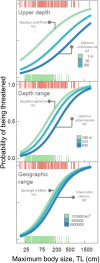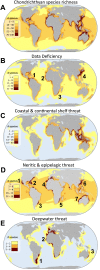Extinction risk and conservation of the world's sharks and rays
- PMID: 24448405
- PMCID: PMC3897121
- DOI: 10.7554/eLife.00590
Extinction risk and conservation of the world's sharks and rays
Abstract
The rapid expansion of human activities threatens ocean-wide biodiversity. Numerous marine animal populations have declined, yet it remains unclear whether these trends are symptomatic of a chronic accumulation of global marine extinction risk. We present the first systematic analysis of threat for a globally distributed lineage of 1,041 chondrichthyan fishes-sharks, rays, and chimaeras. We estimate that one-quarter are threatened according to IUCN Red List criteria due to overfishing (targeted and incidental). Large-bodied, shallow-water species are at greatest risk and five out of the seven most threatened families are rays. Overall chondrichthyan extinction risk is substantially higher than for most other vertebrates, and only one-third of species are considered safe. Population depletion has occurred throughout the world's ice-free waters, but is particularly prevalent in the Indo-Pacific Biodiversity Triangle and Mediterranean Sea. Improved management of fisheries and trade is urgently needed to avoid extinctions and promote population recovery. DOI: http://dx.doi.org/10.7554/eLife.00590.001.
Keywords: biodiversity change; extinction risk; fishes; life histories; population biology; sharks and rays.
Conflict of interest statement
The authors declare that no competing interests exist.
Figures











Comment in
-
Counting the cost of overfishing on sharks and rays.Elife. 2014 Feb 5;3:e02199. doi: 10.7554/eLife.02199. Elife. 2014. PMID: 24499984 Free PMC article.
References
-
- Akcakaya HR, Ferson S, Burgman MA, Keith DA, Mace GM, Todd CR. Making consistent IUCN classifications under uncertainty. Conservation Biology. 2000;14:1001–1013. doi: 10.1046/j.1523-1739.2000.99125.x. - DOI
-
- Anderson SC, Farmer RG, Ferretti F, Houde ALS, Hutchings JA. Correlates of vertebrate extinction risk in Canada. Bioscience. 2011a;61:538–549. doi: 10.1525/bio.2011.61.7.8. - DOI
-
- Anderson SC, Flemming JM, Watson R, Lotze HK. Serial exploitation of global sea cucumber fisheries. Fish and Fisheries. 2011b;12:317–339. doi: 10.1111/j.1467-2979.2010.00397.x. - DOI
-
- Barker MJ, Schluessel V. Managing global shark fisheries: suggestions for prioritizing management strategies. Aquatic Conservation: Marine and Freshwater Ecosystems. 2005;15:325–347. doi: 10.1002/aqc.660. - DOI
Publication types
MeSH terms
LinkOut - more resources
Full Text Sources
Other Literature Sources
Research Materials

